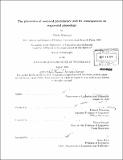| dc.contributor.advisor | Edward Flemming and Donca Steriade. | en_US |
| dc.contributor.author | Giavazzi, Maria | en_US |
| dc.contributor.other | Massachusetts Institute of Technology. Dept. of Linguistics and Philosophy. | en_US |
| dc.date.accessioned | 2011-04-25T15:54:06Z | |
| dc.date.available | 2011-04-25T15:54:06Z | |
| dc.date.copyright | 2010 | en_US |
| dc.date.issued | 2010 | en_US |
| dc.identifier.uri | http://hdl.handle.net/1721.1/62408 | |
| dc.description | Thesis (Ph. D.)--Massachusetts Institute of Technology, Dept. of Linguistics and Philosophy, 2010. | en_US |
| dc.description | Cataloged from PDF version of thesis. | en_US |
| dc.description | Includes bibliographical references (p. 191-199). | en_US |
| dc.description.abstract | Only very few phonological processes are reported to be conditioned by stress. There are two major patterns of stress-sensitive processes: segments are lengthened under stress, and vowels become louder. Two other phonological patterns are reported in the presence of stress, although they don't seem to enhance prominence of the stressed position: the preservation of segmental contrast and the enhancement of acoustic properties of the releases in stress-adjacent consonants. The main question of this dissertation is why there are so few segmental processes that show sensitivity to stress. Why are the major segmental processes affecting consonants (e.g. place assimilation, nasalization and voice neutralization) not sensitive about whether their trigger or target is in a stressed position? The analysis of prosodic conditioning presented here has three components: First every stress-conditioned process is enforced by a markedness constraint requiring the perceptual prominence of a metrically strong position. Languages use two strategies to implement this prominence: increasing the duration of the stressed position, or increasing the perceptual energy of the stressed vowel. Second, increasing the loudness of the stressed vowel has side-effects on the realization of stress adjacent stop releases, which result from the subglottal mechanisms used to produce the increase in loudness. These side-effects constitute the small class of stress-conditioned segmental alternations which are not directly enhancing the prominence of the stressed position. Third, both the effects of prominence requirements and the side-effects of prominence enhancement on the phonetic realization of segments in stressed positions may affect the perceptual distinctiveness between contrasting sounds in stressed positions: if the perceptual distinctiveness between contrasting sounds is decreased in a stressed position, contrast neutralization might arise. If the perceptual distinctiveness between contrasting sounds is increased in a stressed position, stress-conditioned contrast preservation might arise. Contrast preservation in stressed positions is therefore not an effect of Positional faithfulness; it emerges as the indirect consequence of prominence enhancement. The set of segmental features which may be targeted by stress-sensitive processes is extremely limited since it is restricted to those features which can be affected by one of three processes: duration, loudness and effects of raised subglottal pressure on stop releases. | en_US |
| dc.description.statementofresponsibility | by Maria Giavazzi. | en_US |
| dc.format.extent | 199 p. | en_US |
| dc.language.iso | eng | en_US |
| dc.publisher | Massachusetts Institute of Technology | en_US |
| dc.rights | M.I.T. theses are protected by
copyright. They may be viewed from this source for any purpose, but
reproduction or distribution in any format is prohibited without written
permission. See provided URL for inquiries about permission. | en_US |
| dc.rights.uri | http://dspace.mit.edu/handle/1721.1/7582 | en_US |
| dc.subject | Linguistics and Philosophy. | en_US |
| dc.title | The phonetics of metrical prominence and its consequences on segmental phonology | en_US |
| dc.type | Thesis | en_US |
| dc.description.degree | Ph.D. | en_US |
| dc.contributor.department | Massachusetts Institute of Technology. Department of Linguistics and Philosophy | |
| dc.identifier.oclc | 710846722 | en_US |
